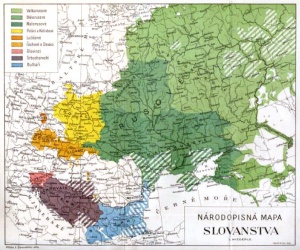Russian language
From Textus Receptus
Russian (русский язык, transliteration: russkiy yazyk, ˈruskʲɪj jɪˈzɨk, meaning 'Russian language') is the most geographically widespread language of Eurasia, the most widely spoken of the Slavic languages, and the largest native language in Europe. Russian belongs to the family of Indo-European languages and is one of three (or four including Rusyn) living members of the East Slavic languages. Written examples of Old East Slavonic are attested from the 10th century onwards. The language is one of the six official languages of the United Nations.
Russian distinguishes between consonant phonemes with palatal secondary articulation and those without, the so-called soft and hard sounds. This distinction is found between pairs of almost all consonants and is one of the most distinguishing features of the language. Another important aspect is the reduction of unstressed vowels, which is somewhat similar to that of English. Stress, which is unpredictable, is not normally indicated orthographically[1] though an optional acute accent (знак ударения) may, and sometimes should, be used to mark stress (such as to distinguish between otherwise identical words or to indicate the proper pronunciation of uncommon words or names).
Classification
Russian is a Slavic language in the Indo-European family. From the point of view of the spoken language, its closest relatives are Ukrainian and Belarusian, the other two national languages in the East Slavic group. In many places in eastern and southern Ukraine and throughout Belarus, these languages are spoken interchangeably, and in certain areas traditional bilingualism resulted in language mixture, e.g. Surzhyk in eastern Ukraine and Trasianka in Belarus. An East Slavic Old Novgorod dialect, although vanished during the fifteenth or sixteenth century, is sometimes considered to have played a significant role in the formation of the modern Russian language. The next closest relatives are the West Slavic languages, especially Polish and Slovak; next are the South Slavic languages, but Bulgarian especially has somewhat different grammar.
The vocabulary (mainly abstract and literary words), principles of word formations, and, to some extent, inflections and literary style of Russian have been also influenced by Church Slavonic, a developed and partly adopted form of the South Slavic Old Church Slavonic language used by the Russian Orthodox Church. However, the East Slavic forms have tended to be used exclusively in the various dialects that are experiencing a rapid decline. In some cases, both the East Slavic and the Church Slavonic forms are in use, with many different meanings. For details, see Russian phonology and History of the Russian language.
Russian phonology and syntax (especially in northern dialects) have also been influenced to some extent by the numerous Finnic languages of the Finno-Ugric subfamily: Merya, Moksha, Muromian, the language of the Meshchera, Veps, et cetera. These languages, some of them now extinct, used to be spoken in the center and in the north of what is now the European part of Russia. They came in contact with Eastern Slavic as far back as the early Middle Ages and eventually served as substratum for the modern Russian language. The Russian dialects spoken north, north-east and north-west of Moscow have a considerable number of words of Finno-Ugric origin.[] Over the course of centuries, the vocabulary and literary style of Russian have also been influenced by Western and Central European languages such as Polish, Latin, Dutch, German, French, and English.[]
According to the Defense Language Institute in Monterey, California, Russian is classified as a level III language in terms of learning difficulty for native English speakers,requiring approximately 780 hours of immersion instruction to achieve intermediate fluency. It is also regarded by the United States Intelligence Community as a "hard target" language, due to both its difficulty to master for English speakers and its critical role in American world policy.
Geographic distribution
The Russian language is primarily spoken in Russia, Belarus, Ukraine, Kazakhstan and Kyrgyzstan, an unofficial but widely spoken language in Ukraine, Latvia and Estonia and, to a lesser extent, the other countries that were once constituent republics of the USSR.[] During the Soviet period, the policy toward the languages of the various other ethnic groups fluctuated in practice. Though each of the constituent republics had its own official language, the unifying role and superior status was reserved for Russian, although it was declared the official language only in 1990.[] Following the break-up of the USSR in 1991, several of the newly independent states have encouraged their native languages, which has partly reversed the privileged status of Russian, though its role as the language of post-Soviet national discourse throughout the region has continued.

In Latvia its official recognition and legality in the classroom have been a topic of considerable debate in a country where more than one-third of the population is Russian-speaking (see Russians in Latvia). Similarly, in Estonia, Russophones constitute 25.6% of the country's current population and 58.6% of the native Estonian population is also able to speak Russian.[] In all, 67.8% of Estonia's population can speak Russian.[] Command of Russian language, however, is rapidly decreasing among younger Estonians (primarily being replaced by the command of English). For example, if 53% of ethnic Estonians between 15–19 claim to speak some Russian, then among the 10–14 year old group, command of Russian has fallen to 19% (which is about one-third the percentage of those who claim to have command of English).[]
